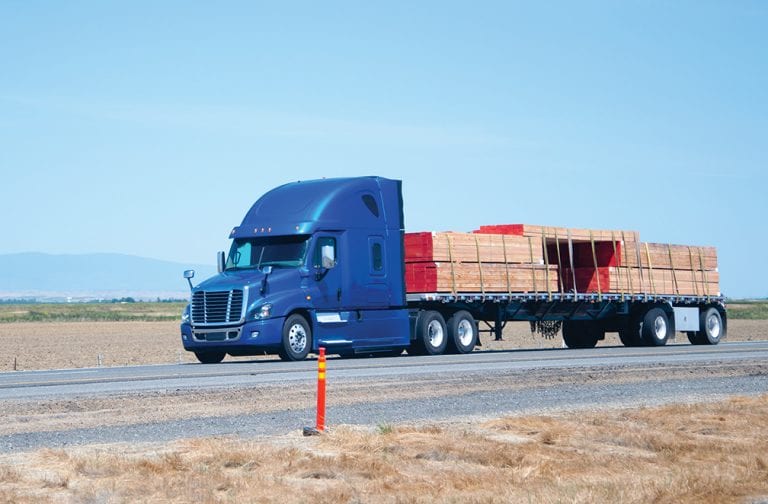Strong freight rates continued to drive trucking revenues upward in April, despite some loss of volume, according to reports received from several sources.
The Cass Freight Index for Shipments, which measures shipments across a variety of transportation modes including rail, pipeline, ship, air and truck, fell by 1.5% from March shipment numbers.
A part of that drop is cyclical. Final months in each quarter (like March) are usually strong, while the following month are typically less so. As the economy rallies back from COVID-19 shutdowns, however, there are additional issues this year. Shortages of semiconductor chips and other products are creating a drag on manufacturing, while record prices for steel and other commodities are slowing assembly lines, particularly in the automotive and heavy-duty truck sectors.
Automotive shipments via railroad dropped about 20% from March to April, according to the Cass report. Steel supplies took a hit when India, the world’s second-largest steel producer, experienced a rash of COVID-19 cases. Oxygen needed for steel production was instead sent to hospitals to treat the growing number of patients.
Another factor is that some of the March shipping was a carryover from February’s polar vortex, pushing March shipment numbers higher than they otherwise would have been.
Compared to 2020, however, the economy is roaring back. The Cass Freight Index of 1.178 in April was 27.6% higher than in April 2020, when the economy was nearing its lowest point.
Compared to April 2019, when nobody had even heard of COVID-19, the shipment index dropped by 1.3%. Without commodity shortages, it’s likely this year’s shipments would have equaled or exceeded 2019 numbers.
While shipments struggle to reach pre-pandemic numbers, the amount of money spent on shipments continues to rise. For example, the Cass Expenditures Index set its fourth new record in five months, coming in a whopping 45.1% higher than the April 2020 index.
The Cass Trucking Index measures freight demand and truck supply. The April index showed a decline from March; however, the index was into positive territory for the 11th consecutive month. Shippers are having difficulty finding enough trucks to haul their products and are paying high rates for those they find.
The trucking industry has experienced difficulty in adding trucks, due to decreased production, as well as drivers, due to worsening shortages. Parts shortages continue to slow truck builders, while the driver shortage continues to grow worse.
The American Trucking Associations (ATA) reported its Truck Tonnage Index fell by 0.3% in April from March levels, losing some of March’s 2.3% increase. The ATA index was 114.7 in April, compared to 115.1 in March.
Bob Costello, chief economist for ATA, sees good days ahead. “The outlook is solid for tonnage going forward as the country approaches pre-pandemic levels of activity, with strong economic growth in key areas for trucking — including retail, home construction and even manufacturing,” he said.
Homebuilding is likely to slow in the coming months due to record lumber prices, along with higher costs for steel and other construction materials.
Costello echoed industry capacity concerns. “Trucking’s biggest challenges are not on the demand side, but on the supply side, including difficulty finding qualified drivers,” he explained.
The list of carriers that have implemented pay raises to attract more drivers (and keep the ones they already have) is growing every week. While pay raises stimulate driver turnover as drivers leave for better pay, they aren’t enough to attract new drivers to an industry that has seen the average age of its workforce climb each year for more than a decade.
DAT’s Truckload Volume Index fell 5% in April from March levels, but it’s important to note that March’s index was a record. According to DAT Freight and Analytics, April was still the second-busiest month on record.
The DAT index measured 225 in April. A baseline of 100 reflects freight volume in January 2015, so the April score is 125% higher.
“It’s not unusual to see a decline from March to April, but truckload freight activity remained at historic levels compared to previous years,” explained Ken Adamo, chief of analytics at DAT. “Trucking companies are in the driver’s seat with respect to pricing power.”
According to DAT, the national average spot rate for van loads posted on its load board dropped by 8 cents per mile from March levels, coming in at $2.59 per mile. While it’s normal for spot rates to decline when freight volumes do, the April figure was still the second-highest on record.
Refrigerated rates declined too, but only by 2 cents per mile to $2.93. Flatbed rates went against the trend, rising 18 cents per mile to $2.96.
Spot rates rose sharply in the second half of 2020 with contract rates expected to follow. They did. DAT reported that average contracted rates — those negotiated in advance of shipment needs — rose to $2.66 for van freight. The increase represented the 12th consecutive month of growth.
The average contract rate for refrigerated freight also grew, but at $2.78 it still lags behind the average spot rate.
Average flatbed rates for the month were the same for both spot and contract freight, $2.96 per mile. An interesting statistic reported by DAT showed nearly 96 loads (95.7) for every available truck posted on their board.
“Spot and contract rates are high as we enter a period when truckload capacity is only going to tighten, as produce and retail goods move ahead of the July 4 holiday and back-to-school shopping season,” Adamo said.
A strange dynamic is in play for rates in the coming months. At some point, commodity shortages will ease, and prices for steel, lumber and other products will come down. Order backlogs are occurring at manufacturers that are experiencing reduced production due to shortages. When production increases, and while truck capacity is still restricted by shortages of new trucks and drivers, rates should experience another bump.
In the meantime, signs are still pointing to a robust period for trucking for at least the next few months. Carriers large and small can make money while being more selective about cargoes and lanes.
Cliff Abbott is an experienced commercial vehicle driver and owner-operator who still holds a CDL in his home state of Alabama. In nearly 40 years in trucking, he’s been an instructor and trainer and has managed safety and recruiting operations for several carriers. Having never lost his love of the road, Cliff has written a book and hundreds of songs and has been writing for The Trucker for more than a decade.















